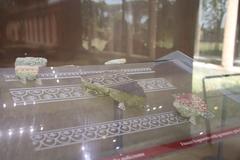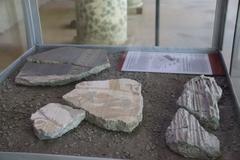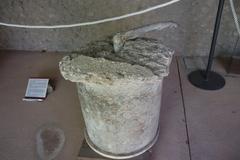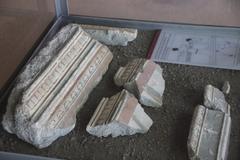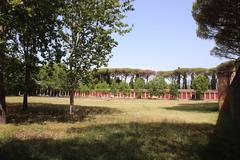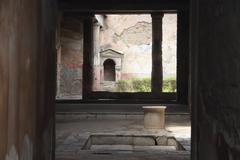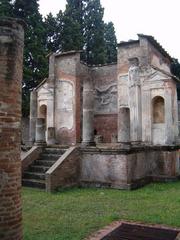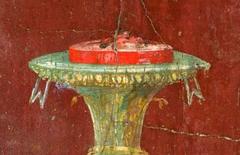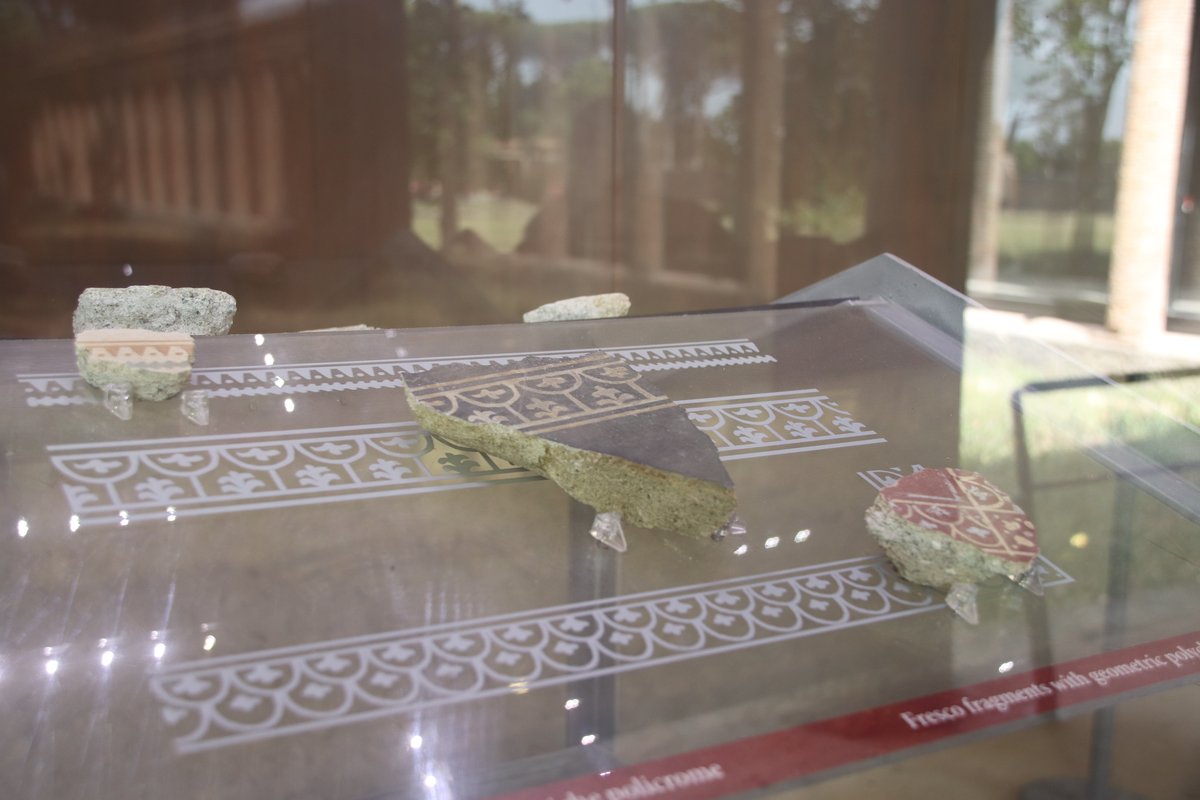
Visiting Natatio in Trecase: Hours, Tickets, and Travel Tips
Date: 01/08/2024
Introduction
Nestled in the Campania region of southern Italy, Trecase is a charming comune that offers a captivating journey through time. With its rich historical tapestry, from ancient Roman ruins to medieval monasteries, Trecase is a destination that caters to history buffs, nature enthusiasts, and those seeking a picturesque escape. One of the most intriguing attractions in Trecase is the Natatio, an ancient Roman bath complex that showcases the advanced engineering and architectural sophistication of the Roman Empire. This comprehensive guide provides essential tourist information, historical context, and practical tips for visiting Trecase and its remarkable sites. Whether you’re planning to explore the iconic Mount Vesuvius, the ancient city of Pompeii, or the stunning Amalfi Coast, Trecase serves as an ideal base for discovering the cultural and natural beauty of the Campania region. For more detailed historical background, you can refer to sources like All That’s Interesting.
Table of Contents
- Introduction
- Historical Background
- Visitor Information
- Travel Tips
- Nearby Attractions
- Special Events and Guided Tours
- Photographic Spots
- Frequently Asked Questions (FAQ)
- Conclusion
Historical Background
Ancient Roman Influence
Trecase’s history dates back to ancient times, with archaeological evidence revealing settlements from the Roman era. Notably, a Roman bath complex was recently unearthed beneath the P.E. Murmura school in Vibo Valentia, featuring niches, columns, and a large swimming pool lined with colorful marble. This bathhouse dates back to the Late Republic (200 B.C.E. to 27 B.C.E.) and early Imperial Rome (27 B.C.E. to the 3rd century C.E.) (All That’s Interesting).
Medieval Period
During the Middle Ages, the vast woods surrounding Trecase served as royal hunting grounds for Frederick II of Swabia and his court. In 1337, the King of Naples’ brother donated the holdings to three monastic communities, giving the area its modern name.
Visitor Information
Trecase Visiting Hours
Most historical sites in Trecase are open from 9:00 AM to 7:00 PM. However, it is advisable to check individual site hours before planning your visit.
Trecase Tickets
Entrance fees vary depending on the site. It is recommended to purchase tickets online in advance to avoid long queues.
Accessibility
Many of Trecase’s historical sites are accessible to visitors with disabilities, although some of the older ruins may present challenges. Check specific site information for accessibility details.
Travel Tips
Best Time to Visit
Spring and early autumn are ideal for visiting Trecase, offering mild weather and fewer crowds.
Local Cuisine
Don’t miss out on local dishes such as pizza margherita and sfogliatella.
Transportation
Trecase is accessible by train from Naples, and local buses are available for getting around.
Nearby Attractions
Mount Vesuvius
A short drive from Trecase, the iconic volcano offers hiking trails and breathtaking views.
Pompeii
Just a few kilometers away, the ancient city of Pompeii provides an unparalleled glimpse into Roman life.
Amalfi Coast
Renowned for its stunning coastline, the Amalfi Coast is a must-visit for any traveler in the Campania region.
Special Events and Guided Tours
Annual Festivals
Trecase hosts several festivals throughout the year, celebrating local culture and history.
Guided Tours
Various companies offer guided tours focusing on the historical and natural beauty of Trecase.
Photographic Spots
Roman Bath Complex
Capture the intricate details of the ancient bathhouse.
Medieval Woods
The lush greenery offers a perfect backdrop for nature photography.
Frequently Asked Questions (FAQ)
Q: What are the main historical sites in Trecase? A: Key sites include the Roman bath complex and medieval monastic holdings.
Q: How can I get to Trecase? A: Trecase is accessible by train from Naples, and local buses are available for getting around.
Q: Are there any special events in Trecase? A: Yes, Trecase hosts several annual festivals celebrating local culture and history.
Visit and Stay Up to Date
Explore more about Trecase by downloading the Audiala mobile app. Check out other related posts and follow us on social media for the latest updates and travel tips.
Exploring the Natatio in Trecase, Italy: Visiting Hours, Tickets, and Historical Significance
Historical Significance
The natatio in Trecase holds a significant place in the historical and cultural landscape of the region. Derived from the Latin word for swimming, ‘natatio’ was a common feature in Roman bath complexes, serving not just as a place for exercise but also as a social hub where people gathered to relax and engage in various activities.
Believed to have been part of a larger Roman bath complex, similar to the famous Baths of Caracalla in Rome, the natatio in Trecase would have been an open-air pool surrounded by high walls and adorned with columns and statues. These monumental structures showcased the engineering prowess and architectural sophistication of the Roman Empire.
Architectural Significance
The architectural design of the natatio in Trecase is a testament to the advanced engineering skills of the Romans. The pool was likely surrounded by walls approximately 20 meters high, providing privacy and a sense of enclosure. Measuring around 50 by 22 meters, the pool was comparable to modern Olympic-sized swimming pools, highlighting the Romans’ appreciation for grand and functional public spaces. The pool would have been lined with marble and decorated with mosaics, adding to its aesthetic appeal.
Social and Cultural Significance
The natatio in Trecase served as a social and cultural hub where people from all walks of life could come together. It provided a space for exercise, relaxation, and entertainment. The surroundings were adorned with niches and statues, creating a visually stimulating environment that encouraged social interaction. Game boards carved into the marble blocks around the pool suggest that the natatio was a lively and vibrant space.
Technological Significance
The construction and maintenance of the natatio in Trecase required advanced technological skills. Part of a larger complex that included various other bathing facilities, such as the caldarium (hot room), tepidarium (warm room), and frigidarium (cold room), these rooms were heated using a complex system of furnaces and air ducts. The natatio itself would have been kept at a pleasant temperature year-round, thanks to a system of furnaces located beneath the pool.
Preservation and Modern Significance
Today, the natatio in Trecase stands as a reminder of the rich cultural and historical heritage of the region. Its remains offer valuable insights into the daily lives of the ancient Romans and their appreciation for public spaces. The preservation of the natatio is crucial for maintaining the historical and cultural legacy of the region.
Visitor Information
Visiting Hours and Tickets
- Visiting Hours: The natatio is open to visitors from 9 AM to 6 PM daily.
- Ticket Prices: Entrance tickets are priced at €10 for adults, €5 for children aged 6-12, and free for children under 6.
Guided Tours
Consider joining a guided tour to gain a deeper understanding of the historical and architectural significance of the natatio. Knowledgeable guides can provide valuable insights and answer any questions you may have.
Photography
The natatio offers numerous photo opportunities, from the grand architecture to the intricate details of the mosaics and statues. Be sure to bring a camera to capture the beauty of this ancient site.
Comfortable Footwear
The site may involve a fair amount of walking, so wear comfortable shoes to ensure a pleasant visit.
Weather Considerations
Since the natatio is an open-air structure, be prepared for the weather conditions. Bring sunscreen, hats, and water if visiting during the summer months, and dress warmly if visiting in the cooler seasons.
Local Attractions
Trecase is located near other historical and cultural attractions, such as the ruins of Pompeii and the beautiful Amalfi Coast. Consider extending your visit to explore these nearby sites.
Respect the Site
As with any historical site, it is important to respect the natatio and its surroundings. Avoid touching or climbing on the structures, and follow any guidelines provided by the site management.
FAQ
Q: Is the natatio wheelchair accessible? A: Yes, the site is equipped with ramps and pathways to accommodate wheelchair users.
Q: Are there guided tours in multiple languages? A: Yes, guided tours are available in several languages, including English, Italian, and Spanish.
Q: Can I buy tickets online? A: Yes, tickets can be purchased online through the official website.
Natatio in Trecase, Italy: Complete Guide to Tickets, Visiting Hours, and Nearby Attractions
Best Time to Visit
Natatio, located in Trecase, Italy, offers a unique blend of historical significance and natural beauty. To make the most of your visit, consider the timing of your trip. The best times to visit are during the spring (April to June) and autumn (September to October) when the weather is mild and the tourist crowds are thinner. During these periods, you can enjoy pleasant temperatures ranging from 15°C to 25°C, making it ideal for exploring outdoor attractions and historical sites.
Getting There
Trecase is well-connected by various modes of transportation. The nearest major airport is Naples International Airport (NAP), located about 25 kilometers away. From the airport, you can take a train or rent a car to reach Trecase. The Circumvesuviana train line connects Naples to Trecase, offering a scenic route through the Campania region. For those driving, the A3 motorway provides direct access to Trecase.
Accommodation
Trecase offers a range of accommodation options to suit different budgets and preferences. For a luxurious stay, consider booking a room at the Hotel Marad, which offers stunning views of Mount Vesuvius and the Bay of Naples. For a more budget-friendly option, the B&B Il Giardino di Tonia provides comfortable rooms and a homely atmosphere. Booking in advance is recommended, especially during peak tourist seasons.
Local Attractions
Natatio
Natatio is an ancient Roman bath complex that dates back to the 1st century AD. It was a place where Roman elites would gather for socializing and relaxation. The site offers a unique opportunity to explore Roman engineering and architectural marvels.
Visiting Hours and Tickets
The site is open daily from 9 AM to 7 PM, with last entry at 6:30 PM. Tickets can be purchased at the entrance for €10 per adult and €5 for children under 12. Guided tours are available and highly recommended to fully appreciate the historical significance of the site.
Highlights
Natatio offers a glimpse into the luxurious lifestyle of the Roman elite. The well-preserved ruins include intricate mosaics, marble columns, and thermal baths. Guided tours are available and highly recommended to fully appreciate the historical significance of the site.
Special Events and Photographic Spots
Throughout the year, Natatio hosts various cultural events and reenactments that bring Roman history to life. Additionally, the site offers numerous photographic spots, particularly around the mosaics and baths, perfect for capturing memorable moments.
Mount Vesuvius
A visit to Trecase is incomplete without exploring Mount Vesuvius, the infamous volcano that destroyed Pompeii and Herculaneum in AD 79. You can hike up to the crater for breathtaking views of the surrounding landscape. The Vesuvius National Park offers guided tours and educational exhibits about the volcano’s history and geology.
Pompeii and Herculaneum
Located just a short drive from Trecase, the archaeological sites of Pompeii and Herculaneum are must-visit destinations. These ancient cities were buried under volcanic ash and have been remarkably preserved. Both sites offer guided tours that provide insights into Roman life, architecture, and culture. Tickets can be purchased online in advance to avoid long queues.
Dining and Cuisine
Trecase is known for its delicious local cuisine, heavily influenced by Neapolitan traditions. Seafood is a staple, with dishes like spaghetti alle vongole (spaghetti with clams) and frittura di paranza (mixed fried fish) being popular choices. For an authentic dining experience, visit Ristorante Il Poeta Vesuviano, which offers a menu featuring local specialties and a selection of fine wines from the Campania region.
Practical Tips
Language
While Italian is the official language, English is widely understood in tourist areas. However, learning a few basic Italian phrases can enhance your experience and help you connect with locals.
Currency
The currency used in Italy is the Euro (€). Credit and debit cards are widely accepted, but it’s advisable to carry some cash for small purchases and in case you visit more remote areas.
Safety
Trecase is generally a safe destination for tourists. However, like any other tourist spot, it’s important to stay vigilant and keep an eye on your belongings, especially in crowded areas. Emergency services can be reached by dialing 112.
Health and Wellness
Italy has a high standard of healthcare, and pharmacies are readily available in Trecase. It’s advisable to carry a basic first-aid kit and any prescription medications you may need. Travel insurance is also recommended to cover any unexpected medical expenses.
Accessibility
Natatio is partially accessible to visitors with mobility issues. Some areas may have uneven ground, so it’s advisable to contact the site in advance to inquire about specific accessibility features.
Local Etiquette
Italians are known for their warm hospitality, but it’s important to be aware of local customs and etiquette. Dress modestly when visiting religious sites, and always greet people with a polite ‘Buongiorno’ (Good morning) or ‘Buonasera’ (Good evening).
FAQ
Q: What are the opening hours for Natatio in Trecase? A: Natatio is open daily from 9 AM to 7 PM, with last entry at 6:30 PM.
Q: How much do tickets to Natatio cost? A: Tickets cost €10 per adult and €5 for children under 12.
Q: Is Natatio accessible for visitors with mobility issues? A: Natatio is partially accessible. Some areas may have uneven ground, so it’s best to contact the site in advance for specific accessibility details.
Q: What is the best time to visit Natatio? A: The best times to visit are during the spring (April to June) and autumn (September to October) when the weather is mild and the tourist crowds are thinner.
Conclusion
Trecase, with its rich blend of historical heritage and natural beauty, offers an unforgettable experience for any traveler. From the ancient Roman marvels of the Natatio to the breathtaking views of Mount Vesuvius, and the archaeological wonders of Pompeii, Trecase is a treasure trove of cultural and historical significance. The town’s accessibility, combined with its range of attractions and local cuisine, makes it a must-visit destination in the Campania region. By planning your visit during the ideal seasons and taking advantage of the available guided tours and cultural events, you can fully immerse yourself in the historical and cultural essence of Trecase. Stay updated with the latest travel tips and information through the Audiala mobile app and explore more related content to enhance your travel experience.
References
- All That’s Interesting, 2024, Author https://allthatsinteresting.com/roman-pool-vibo-valentia
